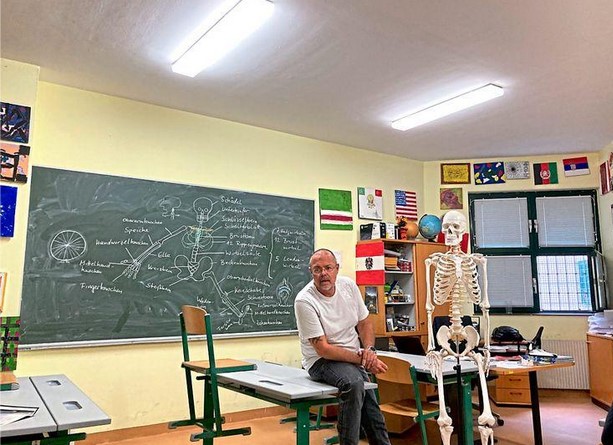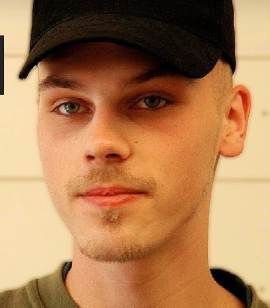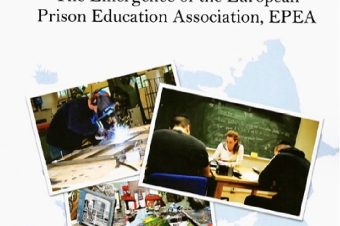Christoph Weltin teaches young offenders at the Josefstadt prison in Vienna – and does so with passion, even though it is often a Sisyphean task. What can school achieve in prison?
Report /Elisa Tomaselli – 20 December 2023, 15:00 h
For teacher Christoph Weltin (55), it doesn’t matter why a young person is in custody. Despite everything, this is a pupil who needs to feel recognised as a person, he says.
Shortly before lunchtime, the class gets loud. Three pupils lower their eyes to their exercise books. Teacher Christoph Weltin stands in front of them and repeats the morning’s material, the topic being the human body. Before he reaches for the skeleton’s hand, a voice echoes from the courtyard.
“Hey Hassan! Hassan!” Weltin continues unperturbed – just like the troublemaker two floors down. “It’s the usual game,” says Weltin, signalling to the boys, including Hassan, with a quick hand gesture that they should be quiet. Weltin sneaks through the classroom, peers through the blinds of the window and opens it quietly.
“Ha!” he calls down. The boys start to giggle. After another attempt, the shouter lets it go.
Weltin currently teaches all subjects to three boys aged between 14 and 16. If you let your gaze wander through his class, it could actually be anywhere: a large blackboard, school desks, classic wooden chairs, a decorated wall with painted pictures – from flags and hearts to abstract figures. The only thing that gives the place away and spoils the classroom idyll for outsiders: the barred windows.
Weltin’s class is probably one of the most segregated in Austria – and his three giggling pupils are underground prisoners. Here in Vienna-Josefstadt, young offenders are remanded in custody and sometimes serve short prison sentences. Female juveniles are sent to a women’s detention centre. According to the Youth Department, an average of 20 to 22 young people between the ages of 14 and 18 are detained here, around one in seven of whom are still of school age. Weltin is there for these boys every morning.
Working as a teacher in prison? Even for the only compulsory school teacher at Josefstadt prison, this was not a job that was initially on his radar – probably because of its exotic nature. A phone call ten years ago changed all that: “I was asked by the prison inspectorate because my predecessor was retiring,” Weltin recalls. At the time, he was a teacher at a special school in Vienna. What prompted the change? “Something could be done, I thought.”
Adapted petty criminals
This remark matches the 55-year-old’s appearance: strong build, white T-shirt, tribal tattoos on his upper arm, prominent laugh lines around his eyes. Weltin comes across as a shirt-sleeved guy whose demanding yet relaxed manner is likely to appeal to young people. And who wants to break with common clichés about young inmates. “Society sometimes rightly perceives them as criminals. But here in prison, they can be the most well-adjusted inmates,” says the teacher.
According to the Youth Welfare Department, the most common offences that bring young people to prison are theft and assault. It is not easy to pinpoint the underlying causes of these offences. “Problem areas can be the family background, false friends and personal risk factors, such as experience of violence or mental illness,” says Weltin, emphasising that these are only probabilities. Weltin does not want to comment on the cases of his students. Because an interview with them was not authorised by the ministry, DER STANDARD handed out anonymous questionnaires to the pupils instead (see info box).
For Weltin as a teacher, the connection to his students is crucial. In his experience, they don’t learn because they find the subjects exciting. “They want to do me a favour as a teacher. And I take advantage of that.” How he manages to get through to the young people sounds as banal as it is well thought out. “It only works with honesty. It’s crucial that they feel recognised as people. For my part, I have to give them clear structures and show them the consequences.” But can you treat a pupil impartially if you know what they are capable of? “I’m good at separating the two,” says Weltin, adding: “He’s still a student, after all.” Ultimately, however, this applies to every professional group in the prison – from social workers to guards. In any case, the good cooperation with his colleagues is an important source of support for him.
In view of Israel’s war against Hamas, the topic of radicalisation surprisingly does not play a major role for his students. “For now,” says Weltin, adding: “I’m sure that it will become more of an issue for us given the current circumstances.” According to Severo Orsi, Head of the Youth Department, Josefstadt also wants to prepare itself for the issue – by organising multicultural workshops, which are currently being developed.
But there are also other things that teacher Weltin still describes as challenging after ten years. For example, when he has a pupil with special needs and a pupil from the HTL in front of him, who have completely different technical requirements. Or when there are sudden interruptions from lawyers or the police, who remind him that his class is a bit different after all.
Constant change of students
And then there is the “Sisyphus effect”: as soon as a workable relationship is established with a pupil, he is released again – or has to move to the juvenile detention centre in Gerasdorf if he has served a longer sentence. It’s a constant coming and going.
Or a return. This is because the reconviction rate for young people is the highest in Austria compared to other age groups. “Unfortunately, that’s the reality, so you have to try to make the best of it.” For him as a teacher, this means: “If I only see his compulsory school leaving certificate or the fact that he will never come back as the yardstick for my success, then I would fail.”
But what effect can school have on a prisoner? “A success can be that he enjoys going to school, that he can read with a good grasp of meaning. Or that they gain a better understanding of their body,” says Weltin. In any case, the school here is the necessary connection to the outside world. And the picture of a pupil is probably also aimed at this outside reality. It says: “Look how I am. Not how I was.”
Statements from two students
What do you like about the school in Josefstadt?
“The teacher. He not only teaches us to learn, but also to be sensible. And that you talk about your worries more often than you do outside.”
What do you look forward to when you’re outside?
“Family, friends and doing what you want to do every day – not what a civil servant tells you to do.”
Original German text of Der Standard (Austria)
https://www.derstandard.at/story/3000000200049/wie-der-schulalltag-hinter-gittern-aussieht
(as at 16 March 2024)
Translation with DeepL
BILDUNG IM GEFÄNGNIS
Wie der Schulalltag hinter Gittern aussieht
In der Wiener Justizanstalt Josefstadt unterrichtet Christoph Weltin straffällig gewordene Jugendliche – und das mit Passion, obwohl es oft einer Sisyphusarbeit gleicht. Was kann Schule im Häfn bewirken?Reportage /Elisa Tomaselli – 20. Dezember 2023, 15:00 h
Für Lehrer Christoph Weltin (55) spielt es keine Rolle, weswegen ein Jugendlicher in U-Haft sitzt. Trotz allem sei dieser ein Schüler, der sich als Person wahrgenommen fühlen muss, sagt er.
Kurz vor Mittag wird es in der Klasse laut. Drei Schüler senken den Blick auf ihre Aufgabenhefte. Vor ihnen steht Lehrer Christoph Weltin und wiederholt den Stoff des Vormittags, Thema ist der menschliche Körper. Ehe er zur Hand des Skeletts greift, schallt eine Stimme aus dem Innenhof herauf.
“Hey Hassan! Hassan!” (Name geändert, Anm.) Weltin setzt unbeirrt fort – wie der Störenfried zwei Stockwerke weiter unten. “Das ist das übliche Spiel”, sagt Weltin und signalisiert den Burschen, darunter Hassan, mit einer schnellen Handbewegung, dass sie still sein sollen. Weltin schleicht durch die Klasse, schaut durch die Jalousien des Fensters, öffnet es leise.
“Ha!”, ruft er runter. Die Burschen fangen an zu kichern. Nach einem weiteren Versuch lässt es der Schreihals bleiben.
Weltin unterrichtet momentan drei Burschen zwischen 14 und 16 Jahren in allen Fächern. Lässt man den Blick durch seine Klasse schweifen, so könnte diese eigentlich überall sein: eine große Tafel, Schulbänke, klassische Holzstühle, eine verzierte Wand mit gemalten Bildern – von Flaggen über Herzen bis hin zu abstrakten Figuren. Das Einzige, das den Ort verrät und die Klassenidylle für Außenstehende trübt: die vergitterten Fenster.
Denn Weltins Klasse ist wohl eine der abgeschottetsten Österreichs – und seine drei kichernden Schüler sind U-Häftlinge. Hier in Wien-Josefstadt kommen straffällig gewordene Jugendliche in Untersuchungshaft und verbüßen teilweise kurze Haftstrafen. Weibliche Jugendliche kommen in eine Abteilung des Frauenvollzugs. Insgesamt sind laut Jugenddepartment durchschnittlich 20 bis 22 Jugendliche zwischen 14 und 18 Jahren untergebracht, etwa jeder Siebente davon ist noch schulpflichtig. Für diese Buben ist Weltin jeden Vormittag da.
Als Lehrer im Gefängnis arbeiten? Auch für den einzigen Pflichtschullehrer in der Justizanstalt Josefstadt war das – wohl auch ob der Exotik – kein Beruf, den er zunächst auf dem Radar hatte. Ein Anruf vor zehn Jahren änderte das. “Die Dienstaufsicht fragte mich damals, weil der Vorgänger in Pension ging”, erzählt Weltin. Zu jenem Zeitpunkt war er Lehrer an einer Wiener Sonderschule. Was den Anstoß zum Wechsel gab? “Da kann man was machen, dachte ich mir.”
Angepasste Kleinkriminelle
Diese Bemerkung passt zum Erscheinungsbild des 55-Jährigen: kräftige Statur, weißes T-Shirt, Tribal-Tattoos am Oberarm, markante Lachfalten um die Augen. Weltin wirkt wie ein hemdsärmeliger Typ, dessen fordernde und zugleich lockere Art bei Jugendlichen ankommen dürfte. Und der mit gängigen Klischees über junge Insassen brechen will. “Die Gesellschaft nimmt sie zum Teil zu Recht als Kriminelle wahr. Hier im Gefängnis können sie aber die angepasstesten Insassen sein”, sagt der Lehrer.
Was die Jugendlichen grundsätzlich in die Justizanstalt bringt, sind laut dem Jugenddepartment am häufigsten Delikte im Bereich Diebstahl und Körperverletzung. Was diesen Delikten tiefer zugrunde liegt, lässt sich nicht so leicht benennen. “Problemfelder können der familiäre Hintergrund, falsche Freunde und persönliche Risikofaktoren sein, etwa Gewalterfahrung oder psychische Erkrankungen”, sagt Weltin und betont, dass es sich hier nur um Wahrscheinlichkeiten handle. Zu den Fällen seiner Schüler will sich Weltin nicht äußern. Weil ein Gespräch mit ihnen vonseiten des Ministeriums nicht genehmigt wurde, hat DER STANDARD stattdessen anonyme Fragebögen an die Schüler ausgeteilt (siehe Infokasten).
Für Weltin als Lehrer ist der Draht zu seinen Schülern entscheidend. Denn seiner Erfahrung nach würden diese nicht lernen, weil sie die Fächer spannend fänden. “Sie wollen mir als Lehrer damit einen Gefallen tun. Und das nütze ich aus.” Wie es ihm gelingt, zu den Jugendlichen durchzudringen, klingt dabei so banal wie durchdacht. “Es geht nur mit Ehrlichkeit. Entscheidend ist, dass sie sich als Personen wahrgenommen fühlen. Ich für meinen Teil muss ihnen klare Strukturen geben und Konsequenzen aufzeigen.” Doch kann man einem Schüler unvoreingenommen begegnen, wenn man weiß, wozu er fähig ist? “Das kann ich gut trennen”, sagt Weltin und fügt hinzu: “Er ist ja trotz allem ein Schüler.” Das betreffe aber letztlich jede Berufsgruppe in der Justizanstalt – von Sozialarbeitern bis hin zu Wachebeamtinnen. Die gute Zusammenarbeit mit dieser Kollegenschaft sei jedenfalls eine wichtige Stütze für ihn.
Mit Blick auf Israels Krieg gegen die Hamas spielt das Thema Radikalisierung bei seinen Schülern überraschenderweise keine große Rolle. “Noch”, meint Weltin und fügt hinzu: “Ich bin mir sicher, dass das angesichts der derzeitigen Umstände verstärkt auf uns zukommen wird.” Auf das Thema angesprochen, will sich auch die Josefstadt laut Jugenddepartment-Leiter Severo Orsi wappnen – mittels multikultureller Workshops, die gerade in Ausarbeitung seien.
Aber es gibt auch andere Dinge, die Lehrer Weltin nach zehn Jahren noch als herausfordernd bezeichnet. Zum Beispiel, wenn er einen Schüler mit Förderbedarf und einen aus der HTL vor sich habe, die fachlich völlig andere Ansprüche stellen. Oder wenn es zu plötzlichen Unterbrechungen durch Anwälte oder die Polizei kommt, die ihn daran erinnern, dass seine Klasse eben doch ein bisschen anders ist.
Ständiger Schülerwechsel
Und dann gibt es noch den “Sisyphus-Effekt”: Sobald eine arbeitsfähige Beziehung mit einem Schüler da ist, wird er wieder entlassen – oder muss in die Justizanstalt für Jugendliche nach Gerasdorf wechseln, wenn er eine längere Haftstrafe ausgefasst hat. Es ist ein ständiges Kommen und Gehen
Oder ein Wiederkommen. Denn bei Jugendlichen ist die Wiederverurteilungsquote im Vergleich zu anderen Altersgruppen in Österreich am höchsten. “Das ist leider die Realität, daher muss man versuchen, das Beste daraus zu machen.” Umgemünzt bedeutet das für ihn als Lehrer: “Wenn ich nur allein seinen Pflichtschulabschluss oder die Tatsache, dass er nie wiederkommt, als Messlatte für meinen Erfolg sehe, dann würde ich scheitern.”
Doch was kann Schule in einem Gefangenen denn bewirken? “Ein Erfolg kann sein, dass er gerne in die Schule geht, dass er sinnerfassend lesen kann. Oder aber auch ein besseres Verständnis für den Körper bekommt”, sagt Weltin. Die Schule hier sei jedenfalls die notwendige Verbindung nach außen in die Realität. Und an diese Realität draußen dürfte sich auch das Bild eines Schülers richten. Darauf steht: “Schau, wie ich bin. Nicht, wie ich war.”
Statements von zwei Bildungsteilnehmenden
Was magst du an der Schule in der Josefstadt?
“Den Lehrer. Er bringt uns nicht nur bei zu lernen, sondern auch vernünftig zu sein. Und dass man öfter über seine Sorgen redet als draußen.”
Worauf freust du dich, wenn du draußen bist?
“Familie, Freunde und jeden Tag zu machen, worauf man Bock hat – und nicht das, was dir ein Beamter sagt.”
https://www.derstandard.at/story/3000000200049/wie-der-schulalltag-hinter-gittern-aussieht
(Stand: 16. März 2024)





![The Teacher’s Voice – Video interview – essentials [EN|GE|ES]](https://www.epea.org/wp-content/uploads/interview21-12-340x226.jpg)
